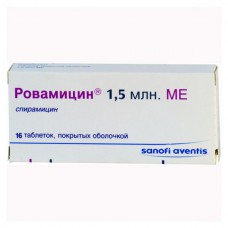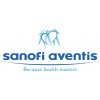Expiration date: 09/2026
The composition and form of issue:
Tablets, film-coated 1 tablet contains:
spiramycin 1, 5 million or 3 million IU
excipients: silica colloidal anhydrous magnesium stearate starch pregelatinized hydroxypropyl cellulose sodium croscarmellose (sodium carboxymethyl cellulose) MCC
in blister packs of 8 (for tablets of 1, 5 million IU) and 5 PCs (for tablets 3 million IU) in a cardboard box 2 blisters.
Powder lyophilized for solution preparation for intravenous administration, 1 vial contains:
spiramycin 1, 5 million IU
in the box 1 vial.
Description pharmaceutical form:
Tablets with a dosage of 1, 5 million IU: round biconvex tablets, coated white or white with a cream shade. On one side is engraved "RPR 107".
Tablets at a dosage of 3 million IU: round biconvex tablets, coated white with a cream shade. On one side is engraved "ROVA 3".
Pharmacokinetics:
Absorption spiramycin is fast, but not full, with a large variability (from 10 to 60%).
Distribution. After oral administration spiramycin at a dose of 6 million ME Cmax in plasma is about 3, 3 µg/ml After I/V administration at doses of 1, 5 million IU by one-hour infusion Cmax in plasma is 2, 3 µg/ml. With the introduction of 1, 5 million IU spiramizina every 8 hours, steady-state concentration is achieved by the end of the second day (Cmax about 3 µg/ml and Cmin of about 0, 5 µg/ml).
Spiramycin penetrates and accumulates in phagocytes (neutrophils, monocytes, peritoneal and alveolar microbacteriology). In humans, the drug concentration inside the phagocytes are high enough. These properties explain the effects spiramizina on intracellular bacteria. Spiramycin not penetrate into the cerebrospinal fluid, however, diffuses into breast milk. Penetrates through the placental barrier (concentration in fetal blood is about 50% of the concentration in the mother's serum). Concentrations in placental tissue 5 times higher than the corresponding concentration in serum. The volume of distribution is approximately 383 L. the Drug is well penetrates into the saliva and tissues (concentration in lung 20-60 mcg/g in tonsils — 20-80 µg/g, infected sinuses — 75-110 µg/g, bones — 5-100 µg/g). 10 days after the end of treatment the concentration of the drug in the spleen, liver, and kidney is 5 to 7 µg/g. Binding to plasma proteins is low (approximately 10%).
Biotransformation. Spiramycin metabolized in the liver to form active metabolites with unknown chemical structure.
Excretion. Excreted mainly in the bile (concentration 15-40 times higher than in serum). Renal excretion of the active spiramizina is (of the administered dose): the ingestion of about 10% when on/in the introduction — about 14%. T1/2 after intake of 3 million ME spiramizina approximately 8 h after I/V administration of 1, 5 million IU spiramizina by one-hour infusion, 5 HR., It can lengthen in older patients. In patients with impaired renal function do not require dose adjustments spiramizina.
Description pharmacological action:
Antibacterial spectrum spiramizina as follows:
- usually susceptible organisms: minimum overwhelming concentration (IPC) &le1 mg/L. More than 90% of strains are sensitive: Streptococcus (including Streptococcus pneumoniae), methicillin-sensitive and methicillin-resistant staphylococci, enterococci, Rhodococcus equi, Branhamella catarrhalis, Bordetella pertussis, Helicobacter pylori, Campylobacter jejuni, Legionella spp., Corynebacterium diphtheriae, Moraxella spp., Mycoplasma pneumoniae, Coxiella spp., Chlamydia spp., Treponema pallidum, Borrelia burgdorferi, Leptospira spp., Propionibacterium acnes, Actinomyces, Eubacterium, Porphyromonas, Mobiluncus, Bacteroides, Peptostreptococcus, Prevotella, Toxoplasma gondii (in vitro and in vivo.), Bacillus cereus
- moderately susceptible organisms: antibiotic moderately active in vitro. Positive results can be observed at concentrations of the antibiotic in the inflammation is higher than the IPC (see the "Pharmacokinetics"). Neisseria gonorrhoeae, Clostridium perfringens, Ureaplasma urealyticum
- resistant organisms (IPC >4 mg/l): at least 50% of strains are resistant: methicillin-resistant staphylococci, Enterobacter spp., Pseudomonas spp. Acinetobacter, Nocardia asteroides, Fusobacterium, Haemophilus spp., Mycoplasma hominis.
Indications:
Pills
infectious diseases caused by susceptible microorganisms, especially of ENT-organs (including tonsillitis, sinusitis), lower respiratory (acute community-acquired pneumonia, including pneumonia caused by atypical organisms, exacerbation of chronic bronchitis)
infection of the periodontium, skin and soft tissues (erysipelas, secondary infected dermatoses, impetigo, ecthyma, erythrasma)
infectious diseases of bones and joints
infectious diseases of the reproductive system (neonorange nature)
prevention of meningococcal meningitis in cases where rifampicin is contraindicated: eradication of Neisseria meningitidis in the nasopharynx. Spiramycin not used to treat meningococcal meningitis, and is recommended for prophylaxis in patients after treatment, and in persons who had contact with the patient 10 days before his hospitalization
the prevention of relapses of acute articular rheumatism in patients allergic to penicillins
toxoplasmosis, including in pregnant women.
Lyophilized powder for preparation of solution for intravenous administration
acute pneumonia
exacerbation of chronic bronchitis
infectious-allergic asthma.
Contraindications:
For both dosage forms:
hypersensitivity to spiramycin and other components of the drug
use in patients with deficiency of the enzyme glucose-6-phosphate dehydrogenase (due to the possible occurrence of acute hemolysis).
For tablets advanced
Children up to age 3 years for tablets 1, 5 million IU to 18 years, for tablets 3 million IU.
For the injectable form
Children and adolescents up to 18 years (for this dosage form), in patients with risk of QT interval prolongation (congenital or acquired), in combination with drugs that can cause ventricular arrhythmia type "torsade de pointes" (antiarrhythmic agents of class Ia — quinidine, hydrogenizing, disopyramide-class III — amiodarone, sotalol, dofetilide, ibutilide) antipsychotic group benzamidov (sultopride), some phenothiazine neuroleptics (thioridazine, chlorpromazine, levomepromazine, trifluoperazine, cyamemazine, amisulpride, tiapride, haloperidol, droperidol, pimozide) halofantrine, pentamidine, moxifloxacin and other drugs, such as bepridil, cisapride, diphemanil, erythromycin/mizolastine, vincamine has.
With caution:
obstruction of the bile ducts
liver failure.
Application of pregnancy and breast-feeding:
If necessary, you can use Rovamycine during pregnancy (spiramycin not revealed teratogenic effects). At the time of treatment should stop breastfeeding (perhaps spiramizina the penetration of breast milk).
For tablets additionally, the reduction in the risk of transmission of toxoplasmosis to the fetus during pregnancy from 25% to 8% when used in the first trimester, from 54 to 19% — in the II and from 65 to 44% in the third trimester.
Side effects:
For tablets
Gastrointestinal: nausea, vomiting, diarrhea, and very rare cases of pseudomembranous colitis (<0, 01%). Described isolated cases of ulcerative esophagitis and acute colitis. It was also noted the possibility of development of acute damage of the intestinal mucosa in patients with AIDS in the application of high doses spiramizina about cryptosporidiosis (2 cases).
Hepatic: very rare (<0, 01%) — changes in liver function tests and the development of cholestatic hepatitis.
The bodies of the blood: very rarely (<0, 01%) — the development of acute hemolysis (see "Contraindications"), and thrombocytopenia.
Of the cardiovascular system: possible prolongation of the interval QT on ECG.
Hypersensitivity reactions: skin rash, urticaria, pruritus very rare (<0, 01%) — angioedema, anaphylactic shock.
For lyophilized powder for preparation of solution for I/V administration
Infrequent and moderately expressed irritation over the course of the vein, which only in exceptional cases, may require cessation of treatment.
Skin allergic reactions.
Other: isolated cases of vasculitis, including purpura Henoch-Schonlein purpura.
Common for both dosage forms
From the peripheral nervous system and CNS: transient paresthesia.
Drug interactions:
Common for both dosage forms
The combination of levodopa and carbidopa: due to inhibition of absorption of carbidopa levodopa level in plasma may be reduced. While the appointment of spiramycin necessary clinical control and a change in dosage of levodopa.
Lyophilized powder for preparation of solution for I/V administration
Should be used with caution with ergot alkaloids.
The development of ventricular arrhythmias, particularly "torsade de pointes". This is a severe violation of rhythm can be caused by a number of antiarrhythmic and no antiarrhythmic drugs. Hypokalemia arising from the application of kaliwavodaschimi diuretics, laxatives drugs incentive, amfoteritina In (in/in), GCS, tetracosactide is a predisposing factor, as well as bradycardia with congenital or acquired prolonged QT interval. Intravenous spiramycin can lead to the development of "torsade de pointes".
When sharing intravenous spiramycin with drugs that cause bradycardia (calcium channel blockers: diltiazem, verapamil, beta-blockers, clonidine, guanfacine, digitalis alkaloids, cholinesterase inhibitors — donepezil, rivastigmine, tacrine, amrinone chloride, galantamine, pyridostigmine, neostigmine), as well as drugs that reduce the level of potassium in the blood (kaliwavodaschimi diuretics, laxatives stimulating character drugs, amphotericin b (in/in), corticosteroids, mineralocorticoids, tetrakozaktid) increases the risk of ventricular arrhythmias, particularly "torsade de pointes". Before the appointment of the drug should eliminate hypokalemia. Recommended clinical and ECG monitoring, and control of electrolyte levels.
Method of application and dose:
Pills
Inside. Adults — 2-3 table. 3 million ME, or 4-6 table. 1, 5 million ME's (i.e. ME 6-9 million) per day in 2-3 reception. Maximum daily dose of 9 million ME.
Children (weighing 20 kg and more) — 150-300 thousand IU/kg/day, divided into 2-3 doses. The maximum dose for children is 300 thousand IU/kg/day. Tablets for ME 3 million children do not apply.
Prevention of meningococcal meningitis: adults — 3 million ME 2 times a day for 5 days children — 75 million ME 2 times a day for 5 days.
Patients with impaired renal function as a result of low renal excretion does not require changes in the dose.
Lyophilized powder for preparation of solution for I/V administration.
The drug is for use only in adults: 1. 5 million ME every 8 h (4, 5 million ME/day) by slow infusion. In the case of severe infections the dose may be doubled.
As soon as the patient's condition, treatment should continue through the reception of the drug inside. The contents of bottle dissolved in 4 ml of water for injection. The drug is injected slowly intravenously over 1 h in 100 ml of 5% dextrose (glucose). The duration of treatment depends on the severity and features of course of infectious process, the sensitivity of the microflora and determined individually by the attending physician. After reconstitution the solution is stable for 12 hours in storage conditions at room temperature.
Overdose:
No known cases of overdose spiramizina.
Lyophilized powder for preparation of solution for I/V administration.
There have been cases of QT interval prolongation after the on/in the introduction spiramizina patients at risk of QT prolongation.
Possible overdose symptoms include (for both forms): nausea, vomiting, diarrhea. There is no specific antidote. If you suspect an overdose spiramycin recommended symptomatic therapy.
Precautions:
In/in the introduction of the drug should be discontinued at the first signs of any allergic reactions.
Because the active component is not eliminated via the kidneys, patients with renal insufficiency dosing regimen should not be changed.
For the injectable form. In patients with liver disease need to monitor its function during the period of drug treatment.
In patients with diabetes (in connection with the use of dextrose) is necessary to monitor blood sugar levels and, if necessary, its correction.
Special instructions:
Pills
In patients with liver disease should periodically monitor its function during the period of drug treatment.



